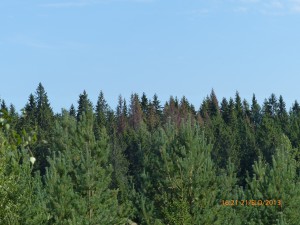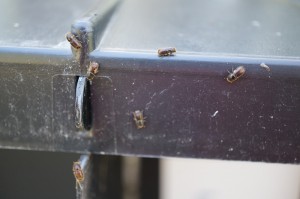 The European spruce bark beetle (Ips typographus L.) has become a major forest pest insect during recent years in the southern and southeastern Finland. Increasing annual mean temperature and storms are providing more suitable habitats for species’ reproduction and survival. I. typographus is a tree killing species and it is inducing patches of dead spruces. Dieback is rapid, thus methods for detection of early symptoms are needed. The main goal of the research is to map and detect damage by the species. In addition, information on varying spatial and temporal scales is needed to produce accurate estimates for population dynamics and the interactions between I. typographus and forest characteristics; long-term and large-scale tendencies, as well as precise small-scale predictions for local damage spots are needed.
The European spruce bark beetle (Ips typographus L.) has become a major forest pest insect during recent years in the southern and southeastern Finland. Increasing annual mean temperature and storms are providing more suitable habitats for species’ reproduction and survival. I. typographus is a tree killing species and it is inducing patches of dead spruces. Dieback is rapid, thus methods for detection of early symptoms are needed. The main goal of the research is to map and detect damage by the species. In addition, information on varying spatial and temporal scales is needed to produce accurate estimates for population dynamics and the interactions between I. typographus and forest characteristics; long-term and large-scale tendencies, as well as precise small-scale predictions for local damage spots are needed.
We have done extensive field inventory in the southeastern Finland during 2012-2014. We also have utilized pheromone trapping for the monitoring purposes. The field information is combined with geographical information systems (GIS) and remote sensing data sets to improve detection accuracy and to enable projections to wider areas. In a case study, we located damage spots from a high resolution aerial imagery in Iitti municipality prior to the field sampling in order to enhance the field inventory. Our recent results show, that population density of I. typographus has been at extraordinary high level within the target areas in study years 2012-2013. Therefore it is even more important to continue monitoring the population densities in order to promote forest health and include these methods to forest management planning and risk assessment.
Remote sensing and GIS  incorporated with climate data enable modeling of species’ distribution and damage intensity. The goal of our incoming task is to produce maps of current and future distribution of the species with spatial modelling. For that purposes, we use ecological niche models (ENMs) and MIGCLIM R dispersal models under different climate change scenarios.
incorporated with climate data enable modeling of species’ distribution and damage intensity. The goal of our incoming task is to produce maps of current and future distribution of the species with spatial modelling. For that purposes, we use ecological niche models (ENMs) and MIGCLIM R dispersal models under different climate change scenarios.

